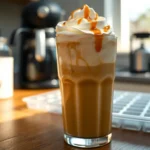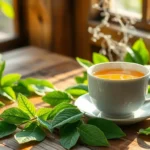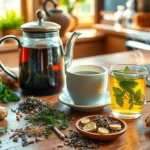White tea represents the purest form of tea craftsmanship – delicate silver buds and tender leaves that undergo minimal processing to preserve their natural elegance. We’ve discovered that this subtle yet sophisticated brew offers a gentle sweetness and light floral notes that make it perfect for those seeking a refined tea experience.
Unlike its more robust counterparts white tea requires a gentle touch and precise technique to unlock its full potential. Many tea enthusiasts struggle with brewing white tea properly often resulting in weak or bitter cups that don’t showcase the tea’s true character. We’ve perfected the art of white tea brewing through years of experimentation and we’re excited to share our foolproof method with you.
Our step-by-step guide will transform your white tea brewing from guesswork into a confident ritual. You’ll learn the optimal water temperature steeping times and techniques that bring out white tea’s naturally sweet and nuanced flavors every single time.
What You’ll Need
Brewing exceptional white tea requires minimal equipment and high-quality ingredients. Our selection focuses on essentials that enhance the delicate brewing process without overwhelming the tea’s subtle character.
Equipment
We recommend gathering these brewing essentials before you begin:
- Teapot or gaiwan – Glass or ceramic vessels work best for temperature control
- Digital thermometer – Precise water temperature monitoring ensures optimal extraction
- Timer – Accurate steeping time prevents over-extraction
- Fine mesh strainer – Removes tea leaves while preserving delicate flavors
- Tea cups – Thin-walled porcelain or glass cups showcase the tea’s pale color
- Kettle with temperature control – Variable temperature settings provide consistency
- Small measuring spoon – Ensures proper tea-to-water ratios
Ingredients
Our ingredient list emphasizes quality over quantity:
- White tea leaves – 1-2 teaspoons of high-grade Silver Needle or White Peony
- Filtered water – 8 ounces of pure water free from chlorine and minerals
- Optional honey – 1/2 teaspoon of raw honey for subtle sweetening
Fresh white tea leaves should appear silvery with visible white downy hairs. We store our tea in airtight containers away from light and moisture to preserve peak freshness. Water quality directly impacts flavor extraction so we always use filtered or spring water rather than tap water.
Preparing Your Tea Setup

Now that we have our essential equipment and quality ingredients ready let’s focus on the crucial preparation steps that determine whether our white tea will shine or fall flat.
Water Temperature Guidelines
We cannot stress enough how critical proper water temperature is for brewing exceptional white tea. The delicate leaves require gentle heat to release their subtle flavors without overwhelming their natural sweetness.
Heat your water to the ideal temperature range of 160°F to 170°F (71°C to 77°C). This exact temperature range preserves the tea’s delicate compounds while extracting optimal flavor. We strongly advise against using boiling water as it destroys the nuanced characteristics that make white tea special.
If you’ve already brought water to a boil don’t worry. Simply let it cool for 5 to 8 minutes before pouring it over your tea leaves. We recommend using a digital thermometer to ensure accuracy until you develop an intuitive feel for the right temperature.
Always use fresh filtered or spring water for the best possible flavor. Tap water with high mineral content or chlorine can mask the subtle notes we’re trying to highlight in our white tea.
Measuring the Tea Leaves
Proper measurement ensures we extract balanced flavors without overpowering the tea’s natural elegance. The ratio varies depending on which type of white tea we’re brewing.
For premium bud teas like Silver Needle use approximately 2 teaspoons per 6 ounces of water. These tightly packed buds contain concentrated flavors that need less leaf material to create a full-bodied cup.
When brewing leafy varieties such as White Peony increase the amount to 2 tablespoons per 6 ounces of water. The larger leaves require more volume to achieve the same flavor intensity as the concentrated buds.
For combination teas that blend both buds and leaves we recommend using 1½ tablespoons per 6 ounces of water. This middle ground accommodates both the concentrated buds and the more open leaf structure.
| White Tea Type | Measurement per 6oz Water |
|---|---|
| Silver Needle (buds) | 2 teaspoons |
| White Peony (leaves) | 2 tablespoons |
| Combination teas | 1½ tablespoons |
Remember that these measurements serve as our starting point. We can always adjust based on personal taste preferences and the exact characteristics of our chosen white tea.
Brewing Instructions

Now we’ll walk through our proven five-step method to brew white tea that captures every subtle note and delicate flavor. This systematic approach ensures consistent results every time you prepare this refined beverage.
Step 1: Heat the Water
We heat our water to the precise temperature range of 160°F to 170°F (71°C to 77°C) for optimal extraction. Boiling water scorches the delicate white tea leaves and creates unwanted bitterness that masks the tea’s natural sweetness. When we don’t have a thermometer available we bring water to a full boil then let it cool for 5 to 8 minutes before using. This cooling period allows the water to reach the ideal temperature zone that preserves the tea’s subtle compounds.
Step 2: Warm Your Teapot or Cup
We pre-warm our brewing vessel by rinsing it thoroughly with hot water. This simple step maintains the optimal brewing temperature throughout the steeping process and enhances our overall tea experience. The warmed vessel prevents temperature shock when we add the heated water and helps extract the tea’s full flavor profile.
Step 3: Add the Tea Leaves
We measure our white tea leaves according to these exact ratios per 6 ounces of water:
| Tea Type | Amount | Water Volume |
|---|---|---|
| Silver Needle | 2 teaspoons | 6 ounces (175 ml) |
| White Peony | 1.5 to 2 tablespoons | 6 ounces (175 ml) |
We place the measured tea leaves directly into our warmed teapot or cup ensuring they have room to expand during steeping. Fresh high-quality tea leaves provide the foundation for exceptional flavor.
Step 4: Pour and Steep
We pour the heated water over the tea leaves ensuring complete submersion for even extraction. Our steeping time ranges from 3 to 5 minutes depending on desired strength with shorter steeping producing lighter flavors and longer steeping creating more robust taste. We recommend tasting the tea starting at 1 minute then at 30-second intervals to find our perfect flavor balance. This gradual approach helps us discover our preferred strength without over-steeping.
Step 5: Strain and Serve
We remove all tea leaves by straining the brewed tea into our serving cups to prevent continued steeping and bitterness. We serve white tea plain without milk or sugar to fully appreciate its delicate floral notes and natural sweetness. Using filtered or spring water throughout the brewing process avoids off-flavors that could overpower the tea’s subtle characteristics.
Timing and Temperature Guidelines

Getting the timing and temperature right is crucial for extracting the delicate flavors of white tea without overwhelming its subtle character. We’ll guide you through the precise parameters that ensure optimal brewing results every time.
First Infusion
We recommend maintaining water temperature between 170–185°F (77–85°C) for most white tea varieties, though especially delicate teas may benefit from temperatures as low as 160°F (71°C). This gentle heat protects the tea’s tender compounds from scorching while allowing proper flavor extraction.
For steeping time, we suggest starting with 3–5 minutes for your first infusion. But, bud-only teas like Silver Needle offer flexibility with steeping times ranging from 1–5 minutes depending on your taste preferences. We encourage sampling your tea at the 1-minute mark to gauge strength and adjust accordingly.
The leaf-to-water ratio plays a critical role in achieving balanced flavor. Use 2 teaspoons of bud-only white tea per 6 ounces of water for varieties like Silver Needle. For leaf-heavy types such as White Peony, increase to 2 tablespoons per 6 ounces of water to compensate for the different leaf structure.
Pre-warming your cups before serving helps maintain the optimal temperature and enhances the tea’s delicate aroma. This simple step ensures you experience the full sensory profile of your carefully brewed white tea.
Multiple Infusions
High-quality white teas reward us with multiple infusions from the same leaves, revealing new flavor dimensions with each subsequent brew. After completing your first steep, we recommend re-steeping the same leaves to maximize their potential.
For each additional infusion, increase the steeping time by 30–60 seconds beyond the previous brew. This gradual approach allows for controlled extraction while preventing over-steeping that could introduce unwanted bitterness.
The beauty of multiple infusions lies in the evolving flavor profile each round provides. Your second infusion may reveal floral notes that were subtle in the first, while the third might showcase deeper, more complex undertones inherent in quality white tea leaves.
Quality white tea leaves can typically yield 3–4 satisfying infusions before their flavor begins to diminish significantly. We find this method not only economical but also educational, as it teaches you to recognize the full spectrum of flavors your tea can offer.
Serving Suggestions

We recommend serving white tea in pre-warmed cups to maintain optimal temperature and preserve the delicate flavors we’ve carefully extracted through proper brewing. The thin-walled porcelain or glass cups we suggested earlier work perfectly for presentation and help showcase the tea’s pale golden color.
White tea’s subtle nature makes it an ideal companion for light refreshments that won’t overpower its gentle character. Fresh fruit such as pears, white grapes, or citrus segments complement the tea’s natural sweetness beautifully. Mild cheeses like fresh goat cheese or creamy brie create a sophisticated pairing that enhances both the tea and food.
Delicate pastries work wonderfully alongside white tea during afternoon service. Consider serving macarons, shortbread cookies, or light sponge cakes that won’t compete with the tea’s refined flavor profile. We find that vanilla-based desserts particularly enhance white tea’s floral notes.
The timing of service matters significantly for white tea enjoyment. Serve immediately after brewing while the temperature remains optimal and the aromatics are most pronounced. Each cup should be consumed within 10-15 minutes to experience the full spectrum of flavors we’ve worked to develop.
Most white teas taste best without any additions, allowing us to appreciate their natural complexity and subtle sweetness. But, a small amount of honey or a thin slice of lemon can enhance certain varieties if desired. We recommend tasting the tea plain first to understand its unique characteristics before considering any additions.
Multiple infusions from the same leaves provide an excellent opportunity to explore how flavors evolve throughout the brewing session. Serve each infusion in clean cups to allow guests to compare the changing taste profiles and appreciate the tea’s depth and complexity.
Storage Tips for White Tea

Proper storage becomes critical once we’ve invested in high-quality white tea leaves and mastered the brewing process. We need to protect our delicate tea leaves from four main enemies: moisture, light, heat, and strong odors that can compromise their subtle flavors.
Airtight containers provide the first line of defense against moisture and air exposure. We recommend using glass jars with tight-fitting lids or metal tins specifically designed for tea storage. These containers prevent oxidation and maintain the tea’s delicate aroma profile that we work so hard to preserve during brewing.
Location matters significantly for long-term tea quality. We should store our white tea containers in cool, dark cupboards away from direct sunlight and heat sources like stoves or radiators. Kitchen cabinets work perfectly as long as they stay consistently cool and dry.
Avoiding common storage mistakes helps preserve our tea’s integrity. We never recommend refrigerator storage unless the container is completely airtight, as condensation and food odors can quickly spoil white tea leaves. The temperature fluctuations from opening and closing the refrigerator door create additional moisture problems.
Freshness timeline guides optimal consumption for the best tea experience. We suggest using white tea within 6 to 12 months of purchase to enjoy peak flavor and aroma. Unlike aged teas, white tea performs best when consumed fresh, maintaining those delicate floral notes we carefully extract during brewing.
| Storage Factor | Recommendation | Duration |
|---|---|---|
| Container Type | Airtight glass or metal | N/A |
| Location | Cool, dark cupboard | N/A |
| Temperature | Room temperature | N/A |
| Optimal Use | Fresh consumption | 6-12 months |
Multiple storage containers work well when we buy white tea in bulk. We can keep a small amount in our daily brewing container while storing the remainder in larger airtight containers. This approach minimizes air exposure to our main tea supply while ensuring convenient access for regular brewing sessions.
Troubleshooting Common Issues

Even experienced tea enthusiasts encounter challenges when brewing white tea’s delicate leaves. We’ve identified the most common problems and their answers to help you achieve perfect results every time.
Tea Tastes Too Weak
Weak white tea often results from incorrect ratios or brewing parameters. We recommend increasing your tea quantity first—use 2 teaspoons of bud-only varieties like Silver Needle per 6 ounces of water or 2 tablespoons of leafy varieties such as White Peony for the same amount. Your water temperature should fall within 160–176°F (71–80°C) range since temperatures below this range extract insufficient flavor compounds.
Extend your steeping time gradually if the tea remains weak after adjusting quantity and temperature. Most white teas benefit from 4–5 minutes of steeping time while bud-only varieties can handle up to 6 minutes without becoming bitter. We suggest tasting every 30 seconds after the 3-minute mark to find your preferred strength. Consider using a higher leaf-to-water ratio as another effective solution—this approach provides more control over flavor intensity than extended steeping alone.
Tea Tastes Too Bitter
Bitter white tea typically indicates excessive heat or oversteeping rather than poor quality leaves. We recommend lowering your water temperature to 160°F and avoiding temperatures above 176°F since white tea’s delicate compounds become harsh when scalded. Spring or filtered water works best as heavy tap water or hard water can contribute to unpleasant astringent notes.
Reduce your steeping time to 3 minutes for your first infusion and taste before deciding whether to continue brewing. White tea produces less bitterness than other tea types but becomes astringent when overbrewed beyond its optimal extraction point. Use fewer leaves if the problem persists—sometimes 1.5 teaspoons instead of 2 teaspoons per serving provides better balance. We always pre-warm our teaware with hot water before brewing since this maintains consistent temperature throughout the process and prevents sudden temperature fluctuations that can shock the leaves.
Conclusion
We’ve walked you through everything you need to know about brewing exceptional white tea. From selecting the right equipment and understanding water temperatures to mastering multiple infusions and proper storage techniques.
The key to success lies in respecting white tea’s delicate nature. Remember to keep your water temperature between 160°F-185°F and don’t rush the steeping process. Quality leaves deserve careful attention.
With these techniques in hand you’re ready to enjoy white tea’s subtle complexity. Each cup will reveal new layers of flavor as you develop your brewing skills and discover your personal preferences.
Frequently Asked Questions
What temperature should I use when brewing white tea?
The optimal water temperature for brewing white tea is between 160°F to 170°F (71°C to 77°C). For most varieties, you can go slightly higher at 170–185°F (77–85°C), but avoid boiling water as it can overwhelm the tea’s delicate compounds and subtle flavors. Use a digital thermometer for accuracy.
How long should I steep white tea?
Steep white tea for 3–5 minutes for the first infusion. Delicate varieties like Silver Needle allow for more flexibility in steeping time. For subsequent infusions, increase the steeping time by 30–60 seconds to maintain flavor strength while preventing bitterness.
How much white tea should I use per cup?
Use 1-2 teaspoons of high-grade white tea leaves per 8 ounces of water. For specific varieties: 2 teaspoons for Silver Needle, 1.5-2 tablespoons for White Peony, and 1½ tablespoons for combination teas per 6 ounces of water.
Can I reuse white tea leaves for multiple infusions?
Yes, high-quality white teas can yield 3–4 satisfying brews from the same leaves. Increase steeping time by 30–60 seconds for each subsequent infusion. This allows you to explore the evolving flavor profiles while maximizing the tea’s potential.
How should I store white tea to maintain freshness?
Store white tea in airtight glass jars or metal tins in cool, dark cupboards away from moisture, light, heat, and strong odors. Avoid refrigerator storage unless containers are completely airtight. Consume within 6-12 months for optimal flavor and aroma.
What equipment do I need to brew white tea properly?
Essential equipment includes a glass or ceramic teapot or gaiwan, digital thermometer, timer, fine mesh strainer, and thin-walled tea cups. These materials provide better temperature control and enhance the overall brewing experience without affecting the tea’s delicate flavors.
Why does my white tea taste weak or bitter?
Weak tea usually results from insufficient tea leaves or short steeping time. Increase the amount of leaves and extend steeping duration. Bitter tea occurs from water that’s too hot or over-steeping. Lower water temperature to 160-170°F and reduce steeping time to 3-5 minutes.
What foods pair well with white tea?
White tea pairs beautifully with light refreshments that complement its subtle flavors. Try fresh fruit, mild cheeses, and delicate pastries. The tea’s gentle sweetness and floral notes work best with foods that won’t overpower its refined character.











